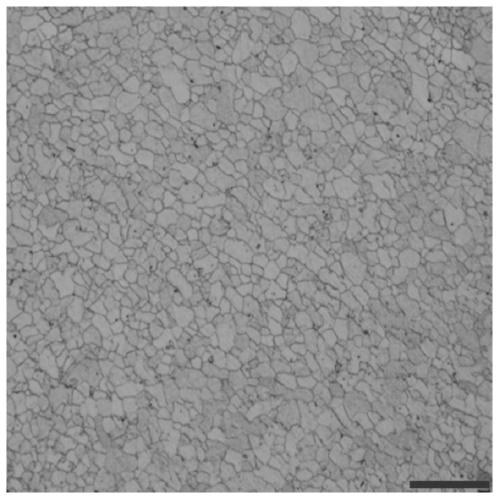A processing method for refining grains of 35crmo alloy steel
A processing method and technology of alloy steel, which are applied in the field of hot processing and subsequent heat treatment of steel materials, can solve the problems of microstructure inheritance, difficult to form new equalization, and achieve low stacking dislocation energy, easy dynamic recrystallization, and improved microstructure uniformity. Effect
- Summary
- Abstract
- Description
- Claims
- Application Information
AI Technical Summary
Problems solved by technology
Method used
Image
Examples
Embodiment 1
[0027] The test uses a 35CrMo alloy steel ingot remelted in an intermediate frequency induction furnace, and its original grain size is ASTM No. 1.0, (the grain size is about 240 microns) such as figure 1 As shown, the experimental material was processed into cylindrical samples.
[0028] First, the sample was heated in a box-type resistance furnace at 10°C·s -1 The heating rate is increased to 1210°C, and the temperature is kept for 16min; then the temperature is increased at 10°C·s -1 The cooling rate is lowered to the deformation temperature of 1050 ° C, and the temperature is kept for 10 minutes; then 0.1s -1 The upsetting test was carried out with a strain rate of 0.35; after the upsetting deformation, it was immediately quenched in water to maintain the high-temperature deformation structure of the sample (such as figure 2 As shown, the grain size is 13.86μm); then put the sample into the cooled heating furnace, and heat up with the furnace at a heating rate of 20°C...
Embodiment 2
[0031] The test adopts the 35CrMo alloy steel ingot remelted in the medium frequency induction furnace, and its original grain size grade is ASTM No.1.0, such as figure 1 As shown, the experimental material was processed into cylindrical samples.
[0032] First, the sample is heated in a box-type resistance furnace at 10°C / s -1 The heating rate is raised to 1200°C and kept for 15 minutes; then at 10°C·s -1 The cooling rate is lowered to the deformation temperature of 1000 ° C, and the temperature is kept for 10 minutes; then the temperature is 0.01s -1 The upsetting test was carried out with a strain rate of 0.4; after the upsetting deformation, it was immediately quenched in water to maintain the high-temperature deformation structure of the sample (such as Figure 4 As shown, the grain size is 18.96μm); then put the sample into the cooled heating furnace, and heat up with the furnace at a heating rate of 20°C / s. When the temperature reaches 850°C, keep it for 30 minutes ...
Embodiment 3
[0035]The test adopts the 35CrMo alloy steel ingot remelted in the medium frequency induction furnace, and its original grain size grade is ASTM No.1.0, such as figure 1 As shown, the experimental material was processed into cylindrical samples.
[0036] First, the sample is heated in a box-type resistance furnace at 11°C / s -1 The heating rate was raised to 1200°C, and kept for 15 minutes; then at 9°C·s -1 The cooling rate is lowered to the deformation temperature of 1025 ° C, and the temperature is kept for 11 minutes; -1 The upsetting test was carried out with a strain rate of 0.35; after the upsetting deformation, it was quenched in water immediately to maintain the high-temperature deformation structure of the sample; then the sample was placed in a cooled heating furnace and heated at 21°C / s The rate increases with the temperature of the furnace. When the temperature reaches 860°C, keep it warm for 35 minutes and then quench it with oil. Ultrasonic quenching is carri...
PUM
| Property | Measurement | Unit |
|---|---|---|
| crystal size | aaaaa | aaaaa |
| crystal size | aaaaa | aaaaa |
| crystal size | aaaaa | aaaaa |
Abstract
Description
Claims
Application Information
 Login to View More
Login to View More - R&D
- Intellectual Property
- Life Sciences
- Materials
- Tech Scout
- Unparalleled Data Quality
- Higher Quality Content
- 60% Fewer Hallucinations
Browse by: Latest US Patents, China's latest patents, Technical Efficacy Thesaurus, Application Domain, Technology Topic, Popular Technical Reports.
© 2025 PatSnap. All rights reserved.Legal|Privacy policy|Modern Slavery Act Transparency Statement|Sitemap|About US| Contact US: help@patsnap.com



